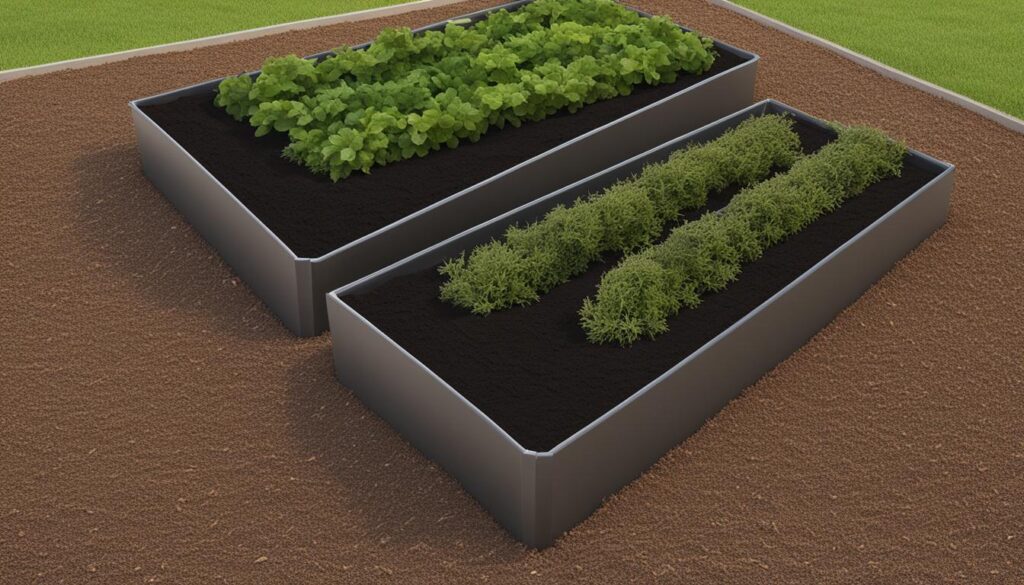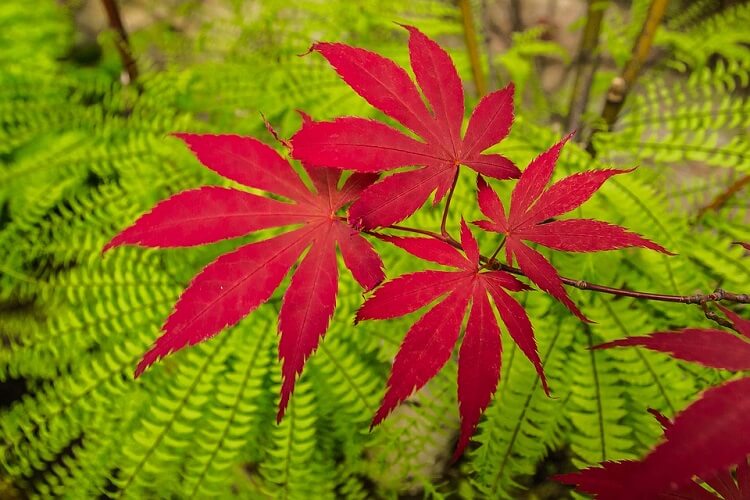Are you tired of spending endless hours weeding and maintaining your garden? Well, we have a solution for you! By using 3 yards of mulch, you can achieve garden success while significantly reducing your weed maintenance. The benefits of mulching are numerous, from conserving water to promoting beneficial insect habitat and increasing soil microbial biodiversity. With deep mulch gardening techniques, you can create a low-maintenance garden that thrives with minimal effort.
Key Takeaways:
- Deep mulch gardening reduces weed maintenance and labor in the garden.
- Using 3 yards of mulch provides many benefits, including water conservation and promoting beneficial insect habitat.
- Mulching helps increase soil microbial biodiversity and reduces the need for additional fertility imports.
- While there may be some drawbacks, such as learning new management systems and dealing with slugs, the benefits of deep mulch gardening outweigh the challenges.
- By implementing deep mulch techniques, you can achieve a healthy and productive garden with minimal irrigation and weed maintenance.
The Importance of Mulch in Your Garden
Mulch plays a crucial role in maintaining a healthy garden. It provides numerous benefits that contribute to the overall success and productivity of your plants. By understanding the importance of garden mulching and the benefits it offers, you can make informed decisions for your garden’s well-being.
One of the significant advantages of mulching is its ability to regulate soil temperature. Mulch acts as insulation, protecting the soil from extreme temperature fluctuations. This is particularly beneficial during hot summer months and cold winter seasons, as it helps plants maintain optimal growth conditions.
Mulch also aids in retaining moisture within the soil. It acts as a protective barrier, slowing down evaporation and reducing water runoff. By conserving moisture, mulch ensures your plants have a constant and adequate water supply, even during dry periods.
Improving soil fertility and structure is another key benefit of mulching. As organic mulch breaks down over time, it enriches the soil with essential nutrients, promoting healthier plant growth. Additionally, mulch enhances soil structure, allowing for better root penetration and nutrient absorption.
By keeping produce off damp soil, mulch helps prevent diseases caused by soil-borne pathogens. It creates a barrier between the ground and the fruits or vegetables, minimizing direct contact and reducing the risk of fungal or bacterial infections.
Mulching also plays a vital role in weed control. A thick layer of mulch suppresses weed growth by blocking sunlight, preventing weed seeds from germinating. With fewer weeds competing for resources, your plants can thrive and allocate their energy towards growth and development.
Moreover, mulch creates pathways in your garden, making it easier to navigate and tend to your plants. These pathways offer convenient access for activities such as watering, harvesting, and general maintenance, minimizing soil compaction and plant damage.
When it comes to organic options for mulch, there is a wide range to choose from. Compost, grass clippings, shredded leaves, straw, wood chips, pine needles, cardboard, and newspaper are all excellent choices. Each type of mulch offers its unique benefits and can be selected based on your specific gardening needs.
It’s important to remember that applying mulch correctly is crucial for maximum effectiveness. The mulch should be spread directly on top of the soil and kept a few inches away from plant bases to prevent moisture-related issues and potential rotting.
In summary, garden mulching is an essential practice to promote the health and vitality of your plants. It regulates soil temperature, retains moisture, improves soil fertility and structure, prevents diseases, eliminates weeds, and creates convenient pathways. By embracing the benefits of mulching, you can create the perfect environment for your garden to thrive.
Different Types of Mulch and How to Apply Them
Mulch is a versatile tool that can be applied at any time in your garden to benefit your plants and soil. Understanding the different types of mulch and proper application techniques can help you make the most out of this gardening practice.
When it comes to mulching, most types of mulch work best when applied with a few inches of depth. This allows for optimal weed suppression, moisture retention, and soil temperature regulation. However, certain types of mulch require specific depths for best results.
For example, when using grass clippings as mulch, it is recommended to apply them in thin layers of one inch at a time. This prevents them from matting and creating a barrier that could hinder water absorption and airflow.
On the other hand, straw mulch is especially beneficial during winter months. To protect your plants from cold temperatures and retain moisture, it’s ideal to apply straw mulch in a depth of 3-4 inches.
When applying mulch, it’s important to avoid directly mulching over newly planted seeds. This can prevent seedlings from emerging and hinder their overall growth. Instead, carefully distribute the mulch around the seeds, leaving space for them to sprout and establish themselves.
Another crucial aspect of mulch application is to spread it evenly on top of the soil. This ensures consistent coverage and a uniform layer that provides the intended benefits. Be sure to keep the mulch a few inches away from the base of your plants, as piling it against the stems can lead to fungal issues and rotting.
Overall, understanding the different types of mulch and how to apply them correctly is essential for maximizing the benefits of this gardening technique. By following these mulching techniques, you can create a healthier environment for your plants, suppress weeds, conserve moisture, and improve the overall fertility of your soil.
Determining Mulch Quantities and Calculations
When it comes to mulching your garden, it’s important to determine the right amount of mulch needed for the job. This can be easily done using a mulch calculator. By inputting the dimensions of your garden or the area you wish to mulch, the calculator will provide you with the exact quantity of mulch required.
The general recommendation for spreading bark mulch is to apply it in a layer that is 2-4 inches deep. This depth allows for sufficient coverage and provides the necessary benefits for your plants and soil.
It’s also helpful to know some basic measurements when considering mulch quantities. One cubic yard of mulch is equal to 27 cubic feet. Most bags of mulch, on the other hand, typically contain 2 cubic feet. Knowing these figures can assist you in determining the amount of mulch needed for your specific garden size.
Once you have established the appropriate mulch depth and have your measurements in place, it’s time to calculate the quantities. If your garden is a simple shape, such as a rectangle, you can calculate the area of the garden and then divide it by the desired mulch depth. This will give you the total volume of mulch needed.
If your garden has multiple sections with different shapes, such as circles or irregularly-shaped areas, you can divide the calculations accordingly. Calculate each section separately and then add the quantities together to get the total mulch needed for your entire garden.
Remember to always consider the desired mulch depth and the specific measurements of your garden to ensure accurate calculations.
With these simple calculations and the help of a mulch calculator, you can determine the precise amount of mulch required for your garden. This will not only ensure proper coverage but also maximize the benefits of mulching, such as moisture retention, weed suppression, and improved soil health.
Benefits of Organic Mulch in Gardens
Organic mulch, such as bark mulch and pine straw, offers several benefits to plants and soil in your garden. By using organic mulch, you can create a healthier environment for your plants and increase overall garden success. Here are some of the key benefits:
- Retains moisture: Organic mulch acts as a natural barrier, preventing water evaporation from the soil. This helps retain moisture levels and reduces the need for frequent watering.
- Stabilizes soil temperature fluctuations: Organic mulch acts as insulation for the soil, protecting it from extreme temperature fluctuations. This promotes stable conditions for plant root development.
- Suppresses weed growth: Organic mulch forms a barrier that inhibits weed germination and growth. It helps smother weed seeds and prevents sunlight from reaching them, reducing the need for manual weeding.
- Adds a decorative touch: In addition to their functional benefits, organic mulches such as bark mulch and pine straw can enhance the aesthetic appeal of your garden. They provide a natural and attractive ground cover.
You can use organic mulch in various types of gardens, including perennial gardens, raised beds, vegetable gardens, and planters. Its versatility makes it a popular choice for gardeners looking to improve soil health and plant growth.
By incorporating organic mulch into your gardening routine, you can enjoy these benefits and create an ideal environment for your plants to thrive.
Conclusion
Mulching is a vital practice for achieving success in your garden. By implementing deep mulch techniques, you can significantly reduce the time and effort spent on weeding while simultaneously enhancing the overall health of your garden.
Various organic mulch options offer numerous benefits, including moisture retention, effective weed suppression, and improved soil fertility. Organic mulch helps conserve water, regulate soil temperature, and create a favorable environment for beneficial insects. It also promotes the growth of beneficial soil microbes, contributing to a thriving garden ecosystem.
To maximize the benefits of mulching, it’s essential to calculate the appropriate amount of mulch needed for your garden and apply it correctly. By using mulch calculators and guidelines, you can ensure that you have the right quantity for your specific garden size and shape. Remember to spread the mulch evenly across the soil, maintaining a distance from the base of plants to prevent rotting and fungal issues.
By adopting the right mulching practices, you can unlock your garden’s full potential. Achieve healthy soil, robust plant growth, and reduced weed maintenance, resulting in a flourishing and low-maintenance garden. Start mulching today and reap the rewards of a beautiful and thriving garden.
What Role Does Mulch Play in Maintaining a Clean and Healthy Garden?
Mulch plays a crucial role in maintaining a clean and healthy garden by regulating soil temperature, retaining moisture, and suppressing weed growth. Additionally, it helps in cleaning artificial turf effectively by preventing soil erosion and reducing the need for excessive watering, thus keeping the garden tidy and free of debris.
FAQ
How does deep mulching reduce the amount of time spent on weeding?
Deep mulching helps to suppress weed growth by creating a thick barrier on top of the soil, making it difficult for weeds to penetrate through. This reduces the need for regular weeding and can significantly reduce the amount of time spent on weed maintenance in the garden.
What are the advantages of using organic mulch in the garden?
Organic mulch offers several benefits to plants and soil. It helps retain moisture, stabilize soil temperature fluctuations, suppress weed growth, and improve soil fertility. By using organic mulch, gardeners can create a healthier environment for their plants and increase overall garden success.
How do I calculate the amount of mulch needed for my garden?
You can calculate the amount of mulch needed for your garden using a mulch calculator. The general recommendation is to spread bark mulch in a 2-4 inch deep layer. One cubic yard of mulch is equal to 27 cubic feet, while most bags of mulch contain 2 cubic feet. Determine the appropriate amount of mulch based on the size of the area to be mulched and the desired depth of mulch.
Can I apply mulch at any time in the garden?
Yes, mulch can be applied at any time in the garden as long as space is left for the plants to grow. It is important to avoid directly mulching over newly planted seeds. Mulch should be spread evenly on top of the soil, keeping it away from plant bases to prevent fungal issues and rotting.
What are some organic options for mulch?
There are various organic options for mulch, including compost, grass clippings, shredded leaves, straw, wood chips, pine needles, cardboard, and newspaper. These materials can provide the benefits of mulching while also decomposing and enriching the soil over time.










